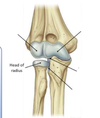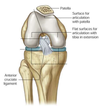MSK HARC booklet Flashcards
WHat is another name for shoulder joint?
glenohumeral joint

. The articular surfaces are covered by ______ ______
hyaline cartilage
The stability of the shoulder joint is dependent on: (3)
- Glenoid labrum – a fibrocartilaginous rim that deepens the glenoid cavity
- Rotator cuff muscles
- Ligaments


You should appreciate that the tendons of rotator muscles blend with the glenohumeral joint capsule to form a_________ _______that surrounds the anterior, posterior, and superior aspects of the joint.
a musculotendinous colla




determine the structures that make up the boundaries of the axilla.
Medial:
Lateral:
Anterior:
Posterior:
Medial: Upper ribs and intercostal spaces covered by the superior part of serratus anterior
Lateral: Intertubercular groove of the humerus
Anterior: Pectoralis major overlying pectoralis minor and subclavius
Posterior: Subscapularis above; teres major and latissimus dorsi below
Name the structures that can be found within the axilla.
Axillary artery (and its tributaries); axillary vein (and its tributaries); cords of the brachial plexus; proximal parts of the coracobrachialis and biceps brachii; lymph nodes; axillary process of the breast.


What are functions of the ligament before?
- Glenohumeral ligament: .
- Coracohumeral ligament:
- Transverse humeral ligament:
- Coracoacromial ligament:
- Glenohumeral ligament: three weak bands of fibrous tissue that run from the glenoid cavity to the lesser tubercle of the humerus extending inferiorly to the anatomical neck.
- Coracohumeral ligament: stretches between the base of the coracoid process of the scapula to the greater tubercle of the humerus.
- Transverse humeral ligament: bridges the gap between the two tubercles of the humerus. Holds the long head of the biceps in the intertubercular groove.
- Coracoacromial ligament: an accessory ligament that extends between the coracoid process and acromion of the scapula


The shoulder joint is the most commonly dislocated large joint. In which direction does it normally dislocate?
Anterior (95%). Most often due to excessive extension and lateral rotation of the arm, or a blow to a fully abducted arm.
Which nerve is most at risk of damage due to an inferior dislocation at the shoulder joint?
The axillary nerve runs close to the joint and surgical neck of the humerus. It can be damaged due to direct compression of the nerve inferiorly as it leaves the axilla by passing through the quadrangular space. This would result in paralysis of the deltoid muscle and loss of sensation over the upper lateral side of the arm (regimental badge area). Injury to the axillary nerve during shoulder dislocation is as high as 40%.
Wear of the rotator cuff is usually related to what?
age
Inflammation and tearing of the rotator cuff is associated with _______ ______ ____
Inflammation and tearing of the rotator cuff is associated with excessive repetitive use
Which muscle of the rotator cuff is most frequently injured?
The supraspinatus. It passes beneath the acromion and acromioclavicular ligament and is therefore most exposed to friction against them during abduction of the shoulder.
Under normal circumstances the amount of friction between the supraspinatus tendon and the acromion is reduced to a minimum by the large s_________ _____, which extends laterally beneath the deltoid.
Under normal circumstances the amount of friction between the supraspinatus tendon and the acromion is reduced to a minimum by the large subacromial bursa, which extends laterally beneath the deltoid.
Degenerative changes in the bursa are followed by degenerative changes in the underlying supraspinatus tendon
What is this called?
subacromial bursitis, supraspinatus tendinitis, or pericapsulitis
What is ‘painful arc syndrome’?
It is the presence of a spasm of pain in the middle range of abduction, which is characteristic of supraspinatus tendinitis. When the glenohumeral joint is adducted, initially no pain is felt, but as the arm is abducted to 50-130 degrees pain occurs as the diseased area impinges on the acromion.


Which of the articulations are primarily involved with the hinge-like flexion and extension of the forearm on the arm?
The articulation between the trochlea of the humerus and the trochlea notch of the ulna, and the articulation between the capitulum of the humerus and the head of the radius.
Which of the articulations is involved with pronation and supination of the forearm?
The articulation between the head of the radius and the radial notch of the ulna.
The elbow joint is supported during movement by the ______ membrane of the joint capsule, which overlies the synovial membrane and encloses the joint.
The ________ membrane is thickened to form ligaments, which support the joint during specific movements:
The elbow joint is supported during movement by the fibrous membrane of the joint capsule, which overlies the synovial membrane and encloses the joint.
The fibrous membrane is thickened to form ligaments, which support the joint during specific movements:
• Radial and ulnar collateral ligaments:
how are they formed?
what movements does it allow?
o Formed by medial and lateral thickening of the fibrous membrane.
o Support the flexion and extension movements of the elbow joint.
• Annular ligament of the radius:
how is formed ?
functions?
o Formed by the lateral free margin of the fibrous membrane that passes around and cuffs the head of the radius.
o Blends with the radial collateral ligament.
o Holds the radial head in place at the proximal radioulnar jo




- The _________ artery is the continuation of the axillary artery at the inferior border of the teres major. It runs medially down the arm giving off several branches, including the profunda brachii artery, before dividing into the radial artery and ulnar artery at the cubital fossa.
- The ______ artery passes along the lateral aspect of the forearm. Its branches in the forearm include the radial recurrent artery and the superficial palmar branch.
- The _____ artery is larger than the radial artery and passes along the medial aspect of the forearm. Its branches in the forearm include the ulnar recurrent artery and the common interosseous artery.
- The brachial artery is the continuation of the axillary artery at the inferior border of the teres major. It runs medially down the arm giving off several branches, including the profunda brachii artery, before dividing into the radial artery and ulnar artery at the cubital fossa.
- The radial artery passes along the lateral aspect of the forearm. Its branches in the forearm include the radial recurrent artery and the superficial palmar branch.
- The ulnar artery is larger than the radial artery and passes along the medial aspect of the forearm. Its branches in the forearm include the ulnar recurrent artery and the common interosseous artery.
Elbow dislocations are common. In which direction does the elbow most commonly dislocate?
Posterior. Usually following a fall on an outstretched hand. The distal end of the humerus is driven through the weak anterior part of the fibrous layer of the joint capsule and the radius and ulna dislocate posteriorly
Which nerve may be damaged by a posterior dislocation of the elbow?
The ulnar nerve, as it passes posterior to the medial epicondyle.
Dislocations of the elbow occur most frequently in children. Why is this?
The parts of the bone that stabilise the joint are incompletely developed. The elbow has six ossification centres around the articular surfaces of the joint. Due to the timing of the closure of these centres, various points are weak across the child’s growth
- The bony fit support provided by the olecranon is not fully formed until the age of 9 meaning that the elbow joint has an inbuilt weakness until that point, which leaves the child more prone to posterior dislocations at the elbow.
- The final ossification centre is at the lateral epicondyle and does not close until the age of 11.
The wrist joint is a synovial joint between the:
- Concave surface of distal end of the radius and the articular disc overlying the distal end of the ulna
- Convex-oval shaped surface formed by the proximal carpal bones - scaphoid, lunate, and triquetral




. A combination of all 4 movements is described as circumduction.
What are these movements
flexion, extension, abduction, and adduction
These muscles are responsible for producing movement at the wrist joint.


: Collectively the carpal bones form an arch. What is the name of the membranous band that spans from medial to lateral across the carpal arch?
Transverse carpal ligament/ flexor retinaculum.
: What is the name of the passage between the membranous band above and the carpal bones below?
Carpal tunnel.















